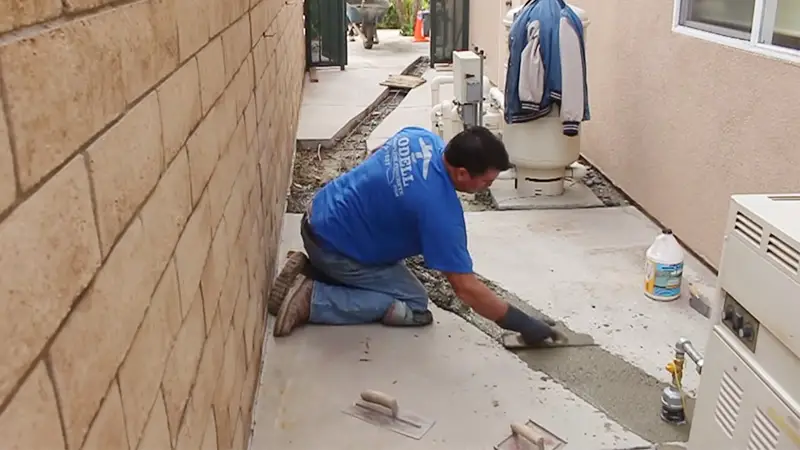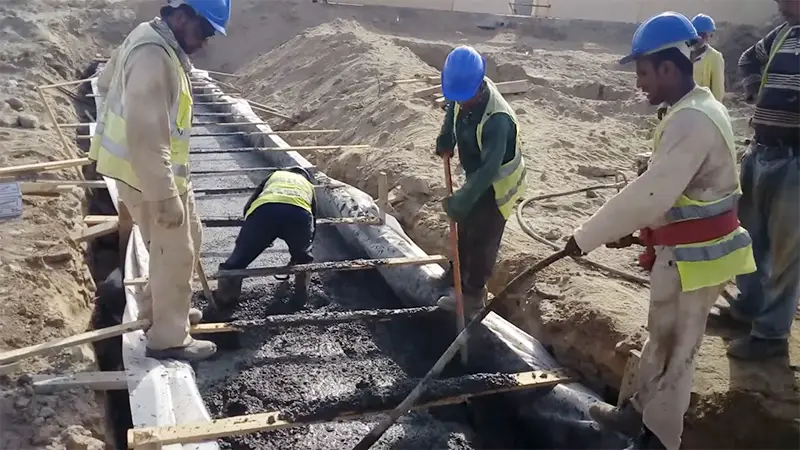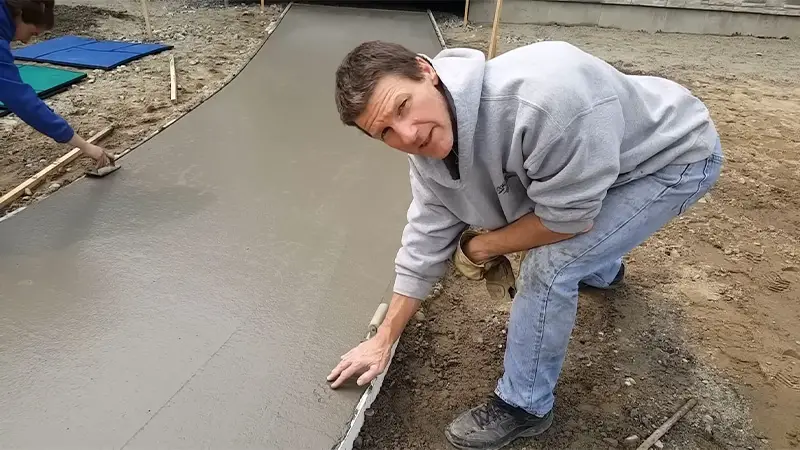When it comes to construction and renovation projects, careful planning and adherence to safety protocols are paramount.
Whether you’re revamping your backyard, adding an extension to your home, or working on a larger construction site, the question of how to deal with buried electrical lines often arises.
Electrical lines play a vital role in powering our homes, offices, and infrastructure. They are typically hidden beneath the ground for safety and aesthetic reasons, keeping our surroundings free of unsightly wires.
But what happens when you need to pour concrete in an area where these underground cables are located? Is it safe? Is it permissible?
I’d say hell no to that. In no way in direct contact. There are places where it is done, but it is simply not a wise thing to do.
Utility cabling or pipes can be laid in conduit and concrete but ensure that they are not subjected to shear forces.
There are four utilities in your home including power, communications, potable water, storm water, gray water, and black water, and each has its own code and requirement, which your local engineer will be able to guide you through.
The utility line could be torn apart, leaks could occur, and the utility system could fail. To protect the content of these ducts and pipes from movement in concrete, we cushion them with crushed stone or sand.
Pouring Concrete Over Buried Electrical Lines?
There are some details missing from this question. The sidewalks in my neighborhood are made of concrete, and there are underground utilities as well.
The feeder must be covered with concrete since the distribution transformer is across the street. Realistically, the lines are in conduits that terminate in transformer enclosures.
Water poured out of the meter enclosure due to a heavy rainstorm (but thankfully not into my walls!) as it went into the pad, down the conduit, and under the street.
To prevent people from digging into electrical lines or driving a fence post into them, electrical lines less than a certain depth must also be covered with concrete by code.
In spite of the fact that the nonmetallic conduit is more than 18 inches deep, I have several runs of conduit under a concrete walkway.
For pulling distribution cables between manholes or underground vaults, a concrete chase (a big concrete tube) may also be used.
It is not uncommon for these to be deep, to have concrete above them, to have roads, to have trees, or anything in between.
What If You Need to Pour Concrete Over Buried Electrical Lines?

I understand you’re considering pouring concrete over your buried electrical lines. Consider the risks and potential complications before you break out that concrete mixer.
Even though it’s technically possible to pour concrete over buried electrical lines, it’s more complicated than one might think.
Are you aware that to hide those electrical lines under a concrete slab, you will need a professional to survey the area and prepare the materials?
Pros and Cons of Pouring Concrete Over Electrical Lines
Lets delve into the pros and cons of this technique to shed light on its feasibility and implications.
Protection:
Pros: One of the primary advantages of pouring concrete over electrical lines is the additional layer of physical protection it provides. The concrete acts as a robust shield, safeguarding the electrical lines from various external threats.
This includes protection against accidental damage caused by construction activities, natural elements, and even potential vandalism.
By encasing the electrical lines in concrete, the risk of critical damage due to external factors is significantly reduced.
Cons: However, the protective benefits of concrete can turn into a detriment if not executed correctly. Improper installation can lead to concrete damaging the insulation or even crushing the electrical lines.
The concrete must be poured with precision to avoid exerting excessive pressure on the wires, which could compromise their integrity.
Durability:
Pros: Once the concrete is set, it becomes incredibly durable and long-lasting. Concrete is known for its resistance to wear and tear, making it an ideal choice for providing extended protection to electrical lines.
This longevity ensures that the lines remain shielded for an extended period, reducing the need for frequent interventions.
Cons: The durability of concrete can also pose challenges. In the event of damage to the concrete layer, repairing it can be complex and costly.
Unlike repairing traditional protective methods, addressing concrete-related issues requires specialized knowledge and equipment, increasing both time and resource investment.
Accessibility:
Pros: Pouring concrete over electrical lines acts as a deterrent to unauthorized access.
The solid layer creates a barrier that discourages tampering, reducing the risk of accidents or unauthorized connections. This is especially relevant in areas where security is a concern.
Cons: Despite its security benefits, the concrete layer can hinder accessibility for maintenance and repair. When electrical lines require attention, the concrete must be cut or broken, making the process more intricate and time-consuming.
This could lead to prolonged downtime and increased costs associated with repairing and restoring the infrastructure.
Cost:
Pros: In the long run, pouring concrete over electrical lines can prove to be cost-effective.
The added protection significantly reduces the likelihood of accidental damage, minimizing the need for frequent repairs and replacements. This can lead to substantial cost savings over the infrastructure’s lifespan.
Cons: However, the initial cost of implementing this technique is higher. The need for additional materials such as concrete and reinforcement, along with increased labor for installation, contributes to the upfront expenses.
The long-term benefits need to be carefully weighed against the initial financial investment.
Environmental Impact:
Pros: Concrete has the potential to prevent erosion around the electrical lines, contributing to local stability. This added stability can protect against soil erosion, minimizing the risk of ground movement that could potentially affect the lines.
Cons: On the flip side, the production of concrete carries a significant carbon footprint. The environmental impact of concrete production and its associated emissions should not be ignored.
As the world moves towards more sustainable practices, it’s important to consider the ecological consequences of using concrete in infrastructure projects.
Installation Complexity:
Pros: Pouring concrete over electrical lines is relatively straightforward once the initial setup is complete. The process involves pouring and setting the concrete, which can be efficiently executed with proper planning.
Cons: However, the initial setup is not without challenges. Careful planning and preparation are necessary, and in some cases, re-routing of electrical service might be required during the pouring process.
This complexity demands meticulous project management to ensure a successful implementation.
Maintenance Complexity:
Pros: The concrete layer significantly reduces the need for routine maintenance, as it acts as a protective barrier against external elements. This can lead to decreased maintenance costs and less frequent disruptions.
Cons: When maintenance is required, dealing with concrete-encased electrical lines becomes more complex.
Professional assistance might be necessary to cut through or break the concrete layer, adding time and costs to the maintenance process.
How To Prepare To Pour Concrete Over Electrical Lines Buried Underground?

Locating buried utility lines is crucial. You don’t want to accidentally strike a power line. Our first step will be to call our local utility locator service. Dialing 811 is usually all it takes.
The team will arrive on site, locate those annoying lines, and mark them. In this way, we can avoid any potential disasters by planning carefully.
Obtaining Necessary Permits
In order to proceed with this project, we need to check if any building permits are required. There have been too many instances where homeowners dive into a project without the necessary permits, and it always ends in disaster.
Let’s examine our local regulations and see what they say. As soon as our utility lines have been marked and all permits have been obtained, we can begin digging the trenches!
Creating space for our concrete pour will require digging around the marked lines. It may be necessary to install a conduit or a protective barrier if we are working with shallow utility lines.
We should always take our time and be extra cautious when working with buried utility lines. Our concrete can be poured safely and efficiently over those lines with proper planning.
Design Considerations
Because buried utility lines need to be repaired or remodeled in the future, you need to consider this before you begin your project.
I try to minimize the chances of requiring access to those lines in the future whenever I design a project. I consider the following:
- Create your layout based on where the lines will be located. Make sure there is enough space for future repairs, whether it is a patio, deck, or garage.
- If you need to access buried lines, choose a shallow paver patio or floating deck that does not require deep excavation.
- You should design your home improvement project so that it can accommodate future expansion without affecting buried utilities.
Using Flowable Fill and Concrete Slab
It is possible that you have heard of flowable fill. When pouring concrete slabs, this awesome material protects utility lines.
This is like liquid concrete, except it isn’t as hard, which makes it perfect for protecting conduits.
Use it effectively by following these steps:
- The trench should be lined with PVC conduit.
- Fill the conduit to the required depth with flowable fill.
- To protect the electrical lines, add a sleeve.
- Over the flowable fill, pour a concrete slab.
Concrete can be poured safely over buried electrical lines as long as the correct procedures are followed, the right materials are chosen, and the necessary precautions are taken.
If you’re unsure what to do, consult a professional.
Potential Dangers of Pouring Concrete over Buried Electrical Lines
Make sure you give your project some extra thought now instead of regretting it later.
Damage to Utility Lines
During the excavation and concrete pouring process, it is vital to consider the risk of damaging electrical and other utility lines.
You may have to pay high repair costs and risk the safety of your entire neighborhood if your lines are damaged or cracked.
It’s time to get those shovels out, but only after you have contacted your local utilities. If you are excavating, stay away from the marked utility lines by at least 18 inches. Instead of heavy machinery, use a hand shovel if you must dig closer.
Electric Shock Hazards
As a safety precaution, I always emphasize the importance of pouring concrete over buried electrical lines. Although it might seem like everything is going smoothly, there is a hidden danger lurking beneath the surface.
There is a serious risk of electric shock from those buried lines if you are not careful. Keep your cool, though! Here are some tips on how to stay safe around those pesky lines.
Any project that involves digging, no matter how DIY-loving you are, should be checked by 811 or a “Call Before You Dig” service before you begin.
This knowledge is crucial for avoiding potential hazards as they mark underground utilities. Don’t hesitate to make that call; you won’t regret it.
Is There Insurance For Buried Power Lines?
Underground electrical wiring is covered by insurance. Damage caused by the following is covered by the insurance:
- Rust
- Wear and tear
- Invasion of tree roots
- Rodents
- Digging
- Ground freeze
- Corrosion
The cost of repairs is high. If you insure buried power lines, you can minimize your expenses. Nevertheless, you can only submit claims if you meet the terms and conditions of the policy.
How Much Does It Cost To Pour Concrete Over Power Lines?
Concrete pouring costs vary. There are several factors to consider:
- Thickness
- Type of finish
- Site preparations
- Square footage
- Location
- Reinforcements
- Concrete grade
Concrete alone costs $278. Aside from that, trenching and excavation costs will also be incurred. There are equipment costs of $4-12 per linear foot and labor costs of $5.75 per foot associated with the process.
What Concrete To Use For Underground Power Lines?
In order to ensure that electrical connections remain functional, you should use the right concrete when covering power lines. In addition to flowable thermal backfill (FTB), controlled density fill (CDF) is also acceptable.
Thermal energy generated by the power lines is dissipated by the FTB. If you have more than one line in a trench, you should use it. CDF is also a flowable fill that easily fills voids while providing support for small and hard-to-reach areas.
The concrete mix also contains additives that make it suitable for underground use. As opposed to sand and cement concrete mix, additives such as geopolymer prevent water from migrating to the buried power lines.
It is very helpful to use sand and bentonite mix for underground high-voltage power lines. Power lines are effectively protected by this mixture, which has great compressive strength and thermal capacity.
Final Words
Your concrete pouring project will go off without a hitch if you follow these tips and keep in touch with your local “Call Before You Dig” service.
There are potential risks associated with pouring concrete over buried electrical lines, such as damage to the lines during construction. It’s not worth the headache!
However, when working around buried power lines, you must exercise caution. A few key points:
- Before starting any construction project, call 811.
- Be aware of land use restrictions and easements.
- Make sure the area is surveyed and prepared by a professional.
- You should use caution when working near buried power lines and wear safety equipment.
- When it comes to specific material concerns, such as asphalt or foundations, consult with professionals.
You will be prepared for a successful, safe, and worry-free project by following these guidelines. I wish you all the best in your construction!








